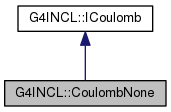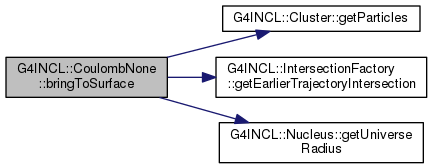|
Geant4
10.03.p02
|
|
Geant4
10.03.p02
|
#include <G4INCLCoulombNone.hh>


Public Member Functions | |
| CoulombNone () | |
| virtual | ~CoulombNone () |
| ParticleEntryAvatar * | bringToSurface (Particle *const p, Nucleus *const n) const |
| Position the particle on the surface of the nucleus. More... | |
| IAvatarList | bringToSurface (Cluster *const c, Nucleus *const n) const |
| Position the cluster on the surface of the nucleus. More... | |
| void | distortOut (ParticleList const &, Nucleus const *const ) const |
| Modify the momenta of the outgoing particles. More... | |
| G4double | maxImpactParameter (ParticleSpecies const &p, const G4double, Nucleus const *const n) const |
| Return the maximum impact parameter for Coulomb-distorted trajectories. More... | |
 Public Member Functions inherited from G4INCL::ICoulomb Public Member Functions inherited from G4INCL::ICoulomb | |
| ICoulomb () | |
| virtual | ~ICoulomb () |
Definition at line 55 of file G4INCLCoulombNone.hh.
|
inline |
Definition at line 58 of file G4INCLCoulombNone.hh.
|
inlinevirtual |
Definition at line 59 of file G4INCLCoulombNone.hh.
|
virtual |
Position the particle on the surface of the nucleus.
This method does not perform any distortion.
| p | incoming particle |
| n | distorting nucleus |
Implements G4INCL::ICoulomb.
Definition at line 50 of file G4INCLCoulombNone.cc.


|
virtual |
Position the cluster on the surface of the nucleus.
This method does not perform any distortion.
| c | incoming cluster |
| n | distorting nucleus |
Implements G4INCL::ICoulomb.
Definition at line 59 of file G4INCLCoulombNone.cc.

|
inlinevirtual |
Modify the momenta of the outgoing particles.
This method does not perform any distortion.
Implements G4INCL::ICoulomb.
Definition at line 83 of file G4INCLCoulombNone.hh.
|
inlinevirtual |
Return the maximum impact parameter for Coulomb-distorted trajectories.
Implements G4INCL::ICoulomb.
Definition at line 87 of file G4INCLCoulombNone.hh.
